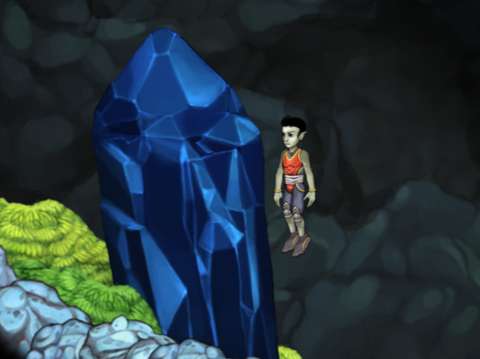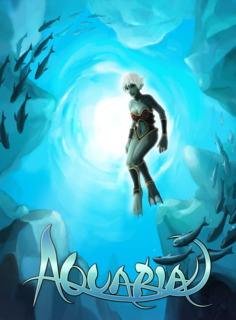INTRO:
Back in 2007, indie games were not as prominent as they are now. They were quite easy to miss, if only because franchise fatigue has yet to set in for so-called mainstream games and there were convincingly then-refreshing high-profile IPs which were making their debut at the time. Thus it was that despite winning the highest Independent Games Festival award of 2008, Aquaria flew under the radar of many people (including this reviewer).
Aquaria is the brainchild of two persons, one of whom would become a prominent indie music composer and the other a game designer who would later become well-known for Spelunky. Its gameplay occurs on a two-dimensional plane, but instead of being yet a typical action-platformer, it offers quite some freedom of movement thanks to its underwater setting. Of more prominence is its story-telling and presentation, which includes highly memorable music.
PREMISE:
Naija is an aquatic but apparently humanoid creature with little recollection of her past. She has been living in a (very extensive) network of underwater caves for a while, but has somehow learned about some of her capabilities, among other more mundane things like recipes with ingredients which are sourced from underwater wildlife and vegetation.
Eventually, after an encounter with a strange-yet-familiar spectral creature, curiosity overcomes her fear of the unknown. She ventures beyond the familiar waters of her home. Out there, she would discover remnants of past underwater civilizations, all seemingly connected to a powerful but bitterly lonely entity, and the survivors of the tumultuous times which brought low these once-impressive ages.
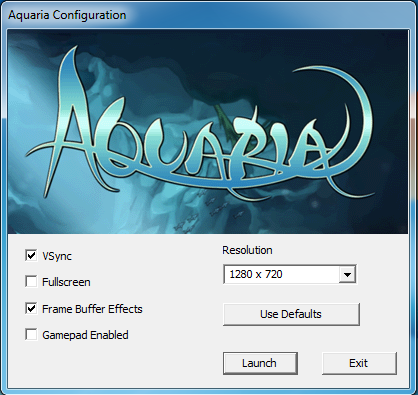
IFFY WINDOWED MODE:
Aquaria might have been designed for the computer platform first, but it was not designed with display versatility in mind.
In particular, its windowed mode is cumbersome to use. The window which runs Aquaria cannot be resized, and clicking on its window overlay causes it to skip about on the desktop. Worse, it cannot be moved about at all; attempting to do so causes the window to skip about even more, irrevocably moving it out of the desktop at times. Furthermore, it locks the mouse cursor into it.
(The Linux version of the game solves this problem of cursor-locking, but it remains in the Windows version to this day.)
MINOR IN-GAME TUTORIAL INACCURACIES:
Early in the playthrough, the player will be provided with a tutorial on the control schemes and some of the basics of the user interface. For the most part, it is satisfactory, and is also well-narrated without breaking the fourth-wall too much.
However, it was perhaps made with earlier versions of the game in mind. In the last build of the game, the tutorial has some inconsistencies with the default controls. For one, the tutorial mentions that the Left Shift button on the keyboard is used for looking about, but the default control input for doing this is actually “E”, if the player checks the Key Config menu (which looks very rudimentary, as if it was added on later without much thought for how it looks).
The tutorial also leaves out features which were introduced post-launch. Some of these features will be mentioned later in this article.
SWIMMING ABOUT:
Since Naija – the player character – is underwater and is very capable of swimming (albeit not as fast as creatures which are better shaped for aquatic life, such as fish), moving about is a simple matter of pointing the mouse cursor at where the player wants her to go to and holding down a button.
Alternatively, the keyboard offers directional motion inputs, but the mouse is perhaps more appropriate for moments outside of combat, considering that many of the levels in the game do not have straight borders. (Combat will be described later.)
If the player wants her to swim faster, there is an option to have her surge forward with a slight variation in the input for swimming at regular speeds. Early in the playthrough, there are only a few moments in which this will be important. As faster threats are revealed as the playthrough progresses, these underwater-equivalent of dashes will become more important to Naija’s survival.

GRIPPING AND LAUNCHING FROM ROCKS:
The underwater world is not all water. Level boundaries are indicated by contiguous formations of rock, which are not merely for show. By swimming into them, Naija can latch onto a wall of rock, and later kick off it for a burst of speed in any possible direction. Gripping rocks also prevent Naija from being swept away by currents, or any vacuum-type attacks which certain enemies have.
This will be Naija’s only form of movement out of water. This statement will be elaborated further later together with the few above-water levels in the game.
However, there is a certain annoyance with this movement feature; it is not useful in narrow places which are underwater. When used in these places, Naija will repeatedly latch onto surfaces for each short jump; each latching takes a second to perform. This actually delays the player’s progress through these places.
SPINNING:
Curious players will learn early on that Naija can spin while swimming; this is done by spinning the mouse cursor around her sprite while having her swim, or more preferably, by holding down the associated keyboard button.
Spinning creates currents which can affect certain creatures. For example, things that latch onto Naija can be forcibly detached from her when she spins. Spinning also happens to attract dropped items towards her too, conveniently. (However, without having resorted to reading tips about spinning, the player will have to learn about this by stumbling into it.)
CURRENTS:
Taking a cue from Rare’s Donkey Kong games (which are perhaps some of the earliest games to feature 2D underwater swimming), there are water currents which either oppose the player character’s movement or aid it, depending on the player’s intended direction of movement. The directions of the currents are conveniently indicated by the waves which move across current-affected regions.
Incidentally, some currents are not incredibly strong; with enough stubbornness, and gripping of rocks and launching from them, the player can fight currents and get Naija to some spots within current-affected regions. On the other hand, Naija will gain a power later which makes these techniques moot.
It is also worth mentioning here that there are few, if any, creatures which swim about in currents. Most hostile creatures will also not pursue Naija into currents as well.

“METROVANIA” ELEMENTS:
The game will inform the player early on that the underwater world is quite extensive. Although the various places, when put together, could hardly be convincingly called a ‘world’, they are numerous enough that the player will be spending hours exploring them.
However, not every place can be reached right from the start. Some places can only be accessed after Naija has obtained certain forms and powers. For example, after learning the ability to levitate objects, Naija can move rocks which are blocking passages, thus gaining access to them.
Interestingly, players with extensive experience in platforming games might attempt to circumvent some obstacles. One example, which is fighting currents, has been mentioned already. However, the game is generally easier to play if the player follows the progression of the acquisition of powers as early as possible.
MAP SYSTEM:
There is a map system to help the player figure out where Naija is and what places are left to explore. However, the map which is shown can seem a bit rudimentary: it shows the outlines of the level boundaries, but not any impassable obstacles which might block the player’s progress. This limitation is particularly noticeable in the Energy Temple, where fallen pillars seal off corridors.
There are icons which depict area-transition nodes, game-save crystals (more on these later) and kitchens (more on these later too), but these icons are so large that they can obscure narrow tunnels and junctions, or even each other if the objects which they represent are close to one another (such as in the case of Naija’s home).
Perhaps the only useful element of the map system are the map markers, which the player can place on the map and with notes of his/her own writing.
It is important to note here that map markers, when placed, appears above Naija’s icon on the map. This is hardly useful, but the map markers can be dragged to where the player wants them to be by clicking on them and holding down the mouse button while moving the mouse about.
However, it would seem that the tool to add markers was only included post-launch, after the tutorials have been finalized. Thus, the player will either have to learn how to use the map markers by experimenting with them, or look through forum posts about the game.
Furthermore, there are only two types of icons for the map markers, and both have the same shapes. This might seem inadequate to a player who would like more visual diversity in order to differentiate map markers with.
There are places which will not appear in the default map view. Instead, they are displayed on a different layer, often imposed on top of the default one. One example is The Song Cave, which appears early on. Having a few layers can seem confusing. Fortunately, these other layers usually involve places which are quite simple in their layout and the player will not be spending much time in them. Returning to the example of The Song Cave, it is a place that is story-critical, but it has only a few junctions and paths.
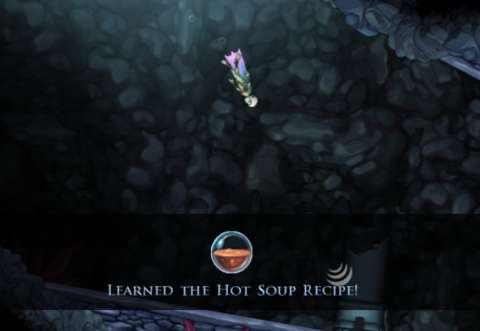
Finally, there are places which are simply not shown on the map at all. These are typically used for so-called secret areas, especially those which house easter eggs. For example, there is a cave which contains two weird-looking bespectacled fish, presumably the caricatures of Derek Yu and Alec Holowka.
SINGING:
As mentioned already, Naija has powers of song. Initially, the player learns about the aesthetic capabilities of her melodies, such as how her singing can attract certain fish (which does have some practical use, as will be mentioned later in the description of docile wildlife).
Next, some of the more useful properties of her singing are revealed: certain aquatic plants and relics respond to specific tunes. In the case of the plants with what appear to be ‘fruits’, the fruits pop, (somehow) yielding goodies such as food items and ingredients, or if the player is unlucky, an odd-looking enemy. There are also certain wildlife which can help Naija if she sings to them, as will be described later.
Afterwards, the player learns about the greater purpose of her songs: they can manipulate and harness magic which grant Naija powers beyond her natural capability. These powers come in the form of magical songs and other physical forms; these will be described later in their own sections.
Singing is also a way of unlocking certain barriers which appear in Naija’s path. The player will need to locate the tunes which act as the keys to the locks; these are often found elsewhere, away from the barriers.
HEALING:
The “Verse”, or the underwater world as Naija describes it, is not without danger. There will be many scenarios where Naija can be harmed. Fortunately, there are a number of ways to have her healed.
The earliest method of healing which the game introduces to the player is the absorption of the energy which is provided by soft blue-illuminated plants. However, the plants will lose their energy afterwards, and it will be a while before they recharge. More importantly, Naija will absorb their energy regardless of her state of health; this means that the player can waste the energy of the plants if she is already at tip-top condition. They also become rarer as the player progresses deeper into the sea.
The next method is the retrieval of life sparks which defeated enemies sometimes leave behind after they disintegrate. These are often a life-saver in pitched fights. The sparks do disappear after a short while, however, and retrieving them is easier said than done if there are still enemies in the vicinity. Two certain forms also provide methods of healing, which will be described later.
Fortunately, there are more reliable and readily available means of healing, the most prominent of which is eating food. The means of getting food will be described shortly.

RECIPES, INGREDIENTS & COOKING:
Naija is, interestingly, a capable cook. She can make use of ingredients which she find in her travels in order to create food items which she can eat in order to heal and gain other buffs. These food items are generally endemic to the world of Aquaria (i.e. they are outlandish). However, there are some recipes such as the pierogi, which is a real dumpling, apparently included as an homage to people who served food to Holowka and Yu during the production of the game. (It was misspelled in-game, however.)
Anyway, ingredients can be obtained by foraging the underwater world for them. The ingredients with the least hassle to obtain are those harvested from plants, but these tend to be far and few in between.
However, the most common source of ingredients is the wildlife – both hostile and docile – in the underwater locales. If the player has no issues doing so, he/she can exploit the singing abilities of Naija’s default form to lure docile fish over, and then switch over to the Energy form to kill them and harvest their flesh.
Hostile wildlife also yield ingredients when they are killed, but getting these can be a bit difficult if fellow members of their species are still milling about where they are.
In addition, all ingredient items will eventually sink downwards. In the case of places with a lot of verticality, this can mean that they sink to the very far bottom. Furthermore, the ingredients do disappear eventually.
After obtaining the necessary ingredients, they can be used for recipes. Recipes can be obtained by finding a finished food item for the first time. Alternatively, recipes can be learned by cooking their associated food item for the first time, without having the recipe beforehand. This will require luck on the player’s part if he/she is not resorting to a guide.
Naija can cook anything at just about any moment, but she can only make recipes which require two ingredients, at least before she obtains a certain treasure. For recipes which require three, she will need access to a kitchen.
There is a kitchen in Naija’s home. For a while, this would be the only one which the player has easy access to. Backtracking to it can be a chore, however. Naija will come across other kitchens, including a couple of old (and strangely functional) ones in the ruins of civilizations which Naija would explore.
Interestingly, some finished food items are themselves ingredients for advanced recipes. The food items which result from these often provide very powerful buffs; some of their ingredients are also rare. They are best reserved for boss battles. Some food items also affect specific forms; these will be described where relevant.
However, these advanced recipes do not always produce food items which are straight upgrades. For example, the Spicy Roll, which requires a regular Hand Roll, does not retain the healing property of the Hand Roll.
Any ingredient combination which does not conform to a recipe will result in a “Sea Loaf”, which is a rather ineffectual food item on its own. However, it is an ingredient which is used in the recipes of some particularly potent food items.

Naija can only carry up to eight units of any type of ingredient or food item, regardless of their apparent size. This limitation can seem a bit annoying, but space can be freed by making use of Naija’s strange ability to cook anything anywhere.
POISONOUS FOOD:
Amusingly, there are some recipes which produce results that can be best described as counter-productive. These usually occur if the player attempts to use poisonous ingredients with anything; obviously, the player will not want Naija to eat the resulting food items.
However, interestingly, these poisonous foods are used as ingredient for recipes which create food items with very specific buffs. The utility of these items is highly situational though. For example, there is a food item which grants the strongest buff to the Energy form, but poisons Naija as well.
DOCILE CREATURES:
The underwater world has life swimming around in it. The first lifeforms that the player encounters are harmless small fish and jellyfish, all of which are somehow attracted to Naija and/or her singing. They are mainly there to add charm to the game. In practical terms, after Naija has obtained the Energy form, they can be killed to yield ingredients.
Larger creatures appear later; it is likely that the game’s creators had included them to diversify the range of docile wildlife and to give the semblance of a living world.
Some of them also have gameplay-related designs, if the player is willing to spend time to experiment with them and observe them. For example, in Naija’s Home Waters, there is a gluttonous sunfish-like creature which usually just floats where it is, until food items or ingredients appear in its vicinity. It will rush over to eat them, and if Naija happens to be in the way, it will unwittingly swallow Naija, before spitting her out violently.
There are some docile creatures with particularly significant gameplay effects. They will be described later in their own section.
HAZARDOUS CREATURES:
Next, there are aquatic creatures that appear to have the function of being mobile hazards; coming into contact with them will hurt Naija. They will not actively seek out Naija, however.
The early ones are easy to avoid. For example, the first few hazardous creatures which the player will encounter are spiny fish which has no business but swimming back and forth in a horizontal line. The later ones are more problematic. For example, the player will encounter large and long primordial creatures which swim about in erratic paths in the darkest depths of the sea.

There are also hazardous creatures who act like hostile creatures, but they do not inflict damage. Instead, they apply de-buffs on Naija. For example, there are black worm-like things which linger in dark caves, waiting to latch onto Naija. When they do so, they slow down her movement; to remove them, Naija has to spin, move into another level, or switch to the Fish form (more on this later).
Interestingly, some hazardous creatures can be moved around using the Bind song. It is not immediately clear why this is so, however; the only clue which the player has is that they are static and are immune to damage.
HOSTILE CREATURES:
Finally, there are creatures which are certainly out to get Naija. All of them seem to be quite united in their purpose; they do not even seem to attack each other, which would of course dash any impression that the creatures in Aquaria are part of some kind of ecosystem.
(On the other hand, it can be argued that some of the creatures have been created or corrupted by the main villain in the game, so that their shared purpose is justified.)
The first of these which the player will discover are small crustacean-like creatures who scuttle back and forth along walls while shooting energy projectiles which seek out Naija. Skilled players will notice that they are quite easy to evade, but there are more powerful variants of such enemies later that can throw forth a wall of such projectiles, only that these are faster.
Later, the player comes across enemies who actually move about to pursue Naija, and shoot stuff at her too, if they have the capability to do so. Examples include nautili which spin before they burst forward, eyeless rays which actively avoid Naija’s own projectiles and huge beasts which are little more than floating turrets (albeit turrets which fire laser beams).
Fortunately, the game applies a shallow learning curve when the player encounters a new enemy. More often than not, in this first encounter, there is only one of this enemy, so the player does have the opportunity to familiarize himself/herself with it.
Moreover, the game will have a few scenarios where the player might notice special interactions between enemies and the environment. For example, in the fallen temple of Mithala, the player might see mutated Mithalans turning into invulnerable but immobile cysts upon coming into contact with poisonous vapours. This will actually be of use later.
Unfortunately, the means to defeat them are not as interesting as their capabilities and behavioral designs. These will be described shortly.
FORMS:
Naija’s natural form is not her only one. After encountering the remnants of civilizations and setting their fallen deities to rest, she can assume other forms. The default method to do so is to sing their associated songs. However, the player can also press the number keys on the keyboard to assume these forms instantly, which is a more efficient way to do so. On the other hand, there may be a lost opportunity to reward players who would rather use the default method, e.g. by granting Naija a buff if the player uses singing instead.

Some forms are used for combat; these forms will be described in their own sections. The other forms are mainly used for accessing other places. For example, there is the Sun form, which has little use other than to access the dark deep places of the underwater world.
Certain forms which have combat utility are also used to access places. For example, there is the Nature form, which lets Naija interact with aquatic plants and static lifeforms which act as barriers or transition nodes to other places.
COMBAT - OVERVIEW:
Initially, Naija’s default form is mostly helpless against anything with hostile intent. Naija will not remain defenseless throughout the game, however. Much of her offensive capabilities are expressed through some of her forms, which she will gain as the playthrough progresses.
Unfortunately, combat in Aquaria is not always a satisfying experience, due to how impractical some of the forms can be, and how boring the practical ones are.
ENERGY FORM:
Naija’s first combat-capable form is the Energy Form. This is perhaps the most practical form to use, mainly because it can fire off projectiles which automatically seek out the enemy which is closest to the mouse cursor.
If the player hovers the mouse cursor over an enemy and tap the Action input, that enemy is highlighted and any projectile which is fired afterwards will automatically seek this enemy instead. However, there does not appear to be any way to disengage the target-locking, other than to lock onto another enemy, kill the first one, or switch to another form and switch back (which is the easiest way).
The Energy form also has an attack which can be charged while Naija is still moving around. When fully charged, the attack releases multiple energy projectiles which are more powerful and faster than the default projectiles. Furthermore, if the player combines the attack with dashes, or wall-launches (or both), more projectiles will be fired. Skillful players can use this to eliminate enemies while fighting in a big open room. (However, there are not exactly many scenarios which have the player fighting enemies in a big room with walls or obstacles to leap from.)
However, the charged attack is a lot less reliable in areas which are not big. This is because the projectiles cannot turn fast enough to avoid hitting obstacles.
Furthermore, this charged attack requires the player to hold the Action input. This would not seem to be a problem, but this means that the player will have to tap the Action input repeatedly in order to make continuous attacks with the default attack. This can lead to sore fingers.
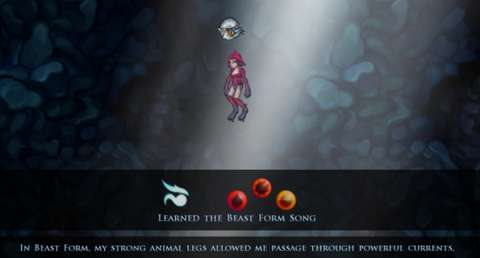
BEAST FORM:
Speaking of narrower places, the Beast form, which Naija obtains later, is perhaps more appropriate for these occasions. This is because it is practically a close-combat weapon; Naija dashes forward to somehow shrink and devour enemies.
The Beast form requires the player to time Naija’s dashes. This is easier said than done, because most enemies will move about. The payoff might be worth the trouble though: any enemies that are smaller or are about Naija’s size and are in Naija’s way will be eaten outright. After eating several creatures, the next one will heal her when she eats it.
If the enemy that is eaten can fire projectiles, Naija can launch a limited number of projectiles by using the Action input. The projectiles which she can fire actually accumulate as she eats more enemies. There is also a food item with a buff which is unique to this form; specifically, it allows the Beast form to fire projectiles without having to eat enemies.
On paper, this seems fantastic. Yet, the Beast form is not useful when there are many enemies to deal with because she can only eat anything when she is dashing, and not when she is just swimming around. If she had been able to eat any small creatures while she is merely swimming around, this form would have been tremendously more useful.
The player could ostensibly use the projectile attacks to even the odds against many enemies, but each projectile can only hit one enemy and it does not do a lot of damage. The direction of a projectile has to be determined by Naija’s swimming direction too; if she stays still, the projectile does not appear to move. (It is unclear whether this is a bug or an intended limitation.) Furthermore, the game does not provide a visual tally of the projectiles which have been accumulated. The accumulated projectiles are also lost if Naija switches forms.
Incidentally, the Beast form is sometimes useful for evasion. Since it is the form which can swim in currents, it can be used to escape from enemies by swimming into currents where they cannot follow. Coupled with the Spider Roll food item, it can also be used for crowd control.
The Beast form also allows Naija to replenish health by eating docile creatures, though finding docile creatures to eat while being chased by enemies can be a tall order.
NATURE FORM:
The Nature form is mostly useless for combat. It can throw seeds around, but the default seeds merely grow into harmless flowers. Rather, these seeds are more useful for triggering responses from certain plants.
However, the Nature form does have a charged attack. The next seed which Naija would launch can be charged up, causing it to sprout into a large thorny spike which damages anything it touches, with the exception of Naija in her Nature form. Ostensibly, it would be devastating against immobile enemies, though there are not many of these. Furthermore, since Naija can latch onto the spike while in her Nature form, it can be used as a platform to jump from.
Unfortunately, there may be a problem in using the seeds effectively. The seeds have inertia, meaning that they will follow slightly parabolic arcs when they are launched; in any case, they will not land where the player is pointing the mouse cursor, but almost always short of it. The player will need a lot of practice before he/she can aim and land the seeds at where he/she wants.
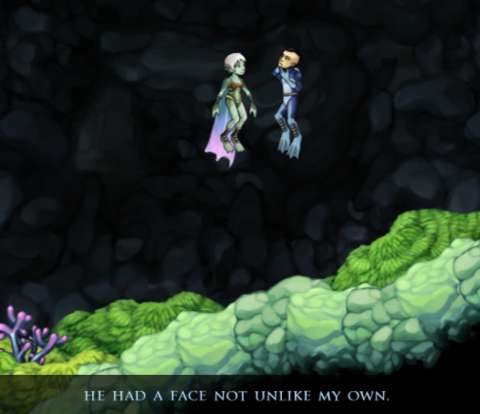
FISH FORM:
The fish form seems to be the second-least useful form for combat. However, since Naija’s humanoid sprite is swapped for a much smaller one, it is useful for slipping away while under fire.
The Swamp Cake can grant a buff which makes contact with the sprite for the fish form poisonous to enemies, but enemies are usually more efficiently handled by being killed with the Energy form’s attack than being poisoned to death.
SPIRIT FORM:
Initially, there is no seeming use for this form in combat. Ostensibly, the method of teleportation that is provided by this form could have been used to evade a storm of projectiles, but Naija’s corporeal body can only reform at blue misty crystals. There are not many of these crystals around.
However, Naija’s spirit form can actually interact with any projectiles which are within its range of movement. Doing so somehow removes them. After several projectiles have been removed, she regains some health. This is incredibly useful in boss fights where the boss spams a lot of projectiles. (The projectiles can still actually harm her spirit form, however, if it comes into contact with them.)
The main problem with the Spirit form is that when Naija reforms, she returns to her default form. It takes a very short while to switch to another form, but the delay can still be considerable in combat.
LI:
After some time has passed in a playthrough, Naija would come across Li, who is a human (his species is confirmed by a certain character which is only seen in the “secret” ending). After having made this acquaintance, Li will accompany Naija on her travels, unless the player chooses to leave him behind in his home cave or Naija’s (for which there really is no incentive to do so).
Li can be hit by projectiles, but he is seemingly indestructible. Furthermore, he has a wrist blaster which can fire a rather powerful projectile, though his rate of fire (and aim) leaves much to be desired.
Since Li can be hit by projectiles, he is also blocked by obstacles, unlike the pets (more on these later). Furthermore, his pathfinding scripts are not particularly excellent. This means that he can fall behind, especially in places with a lot of turns and bends. Fortunately, there is a song which has specifically made for the purpose of respawning Li close to Naija. Li also has no collision scripts against Naija too.
DUAL FORM:
Late into the game, Naija gains the ability to somehow merge with Li, thus creating the Dual Form. There are two variants of this form, which have to be accessed by having the player character spin.
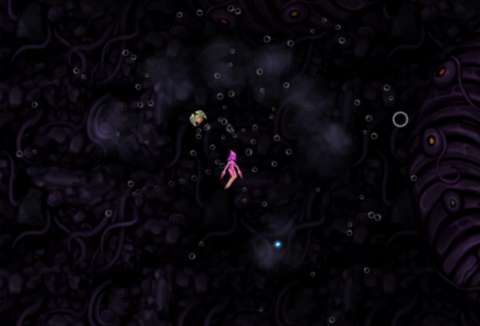
The primary variant of this form is a slightly monstrous version of Li (whose voice-over is still Naija’s anyway). The player can have it charge up an attack, which when released, is composed of three energy “waves” (for lack of a better word to use). These three waves are more than likely to obliterate any small enemy which happens to be in front of the player character, but they appear to disperse away from each other as they travel further from the player character. This makes this attack less useful for attacking at long range (though the middle wave still travels along the player’s intended direction).
The main function of the primary variant of the form is to destroy enemies and absorb their essence. This will not heal the player character, but with three enemies which have been disposed of in this manner, this enables the attack of the other variant of this form.
The other variant of this form is an also-slightly monstrous version of Naija. Upon gaining three kills with Li’s variant, Naija’s variant can charge up and release a banshee scream which kills any regular enemy outright. This will be of use in the finale sections, and certain optional boss fights which swamp the player with many lesser enemies.
LOOKING AHEAD & “SNIPING”:
The default camera zoom may not always be enough to help the player see what is ahead, so there is a function to “look” ahead. Essentially, this gives the player some limited control over the placement of the camera. By holding down the “look” button and moving the mouse about, the player can see up to almost one screen ahead in any direction, depending on the camera zoom.
The main use of this function is, of course, to spot incoming danger. Alternatively, it can also be used to “snipe” enemies before Naija comes into their range of detection. Conveniently, the Energy form’s projectiles can travel for considerable distances, so they can hit something that is quite far away. However, highlighting targets for seeking projectiles does not appear to be possible while the player is using the “look” function.
It is also notable that different enemies appear to have different detection ranges, as the “look” function would reveal. For example, most enemies only detect Naija when she gets within one screen’s distance; looking ahead allows the player to spot these enemies before they detect Naija. However, a certain enemy which appears in the Sunken City can detect Naija from far away, which can spell trouble because they have a dash attack that would be very difficult to see coming without making use of the “look” function.
SHIELD SONG:
Naija starts a playthrough with the Shield song already learned. This grants her immunity to most projectiles, which might be useful if the player wants to have her escape from a storm of projectiles. Later in the game, the Spirit form is far better for dealing with projectiles, especially considering that it pauses time too.
USING BIND SONG FOR COMBAT:
The Bind song (which is the game’s take on telekinesis or levitation) can presumably be used for the purpose of offense. After using it on a rock, the player can attempt to drop the rock on enemies which are below it.
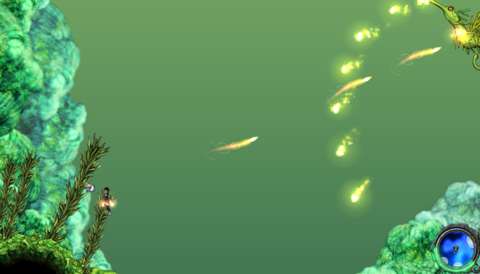
Unfortunately, the speed of the sinking rock is too slow to catch most enemies; most enemies will not actively avoid the rock, but they will still move about such that the rock is not likely to do much at all anyway. Furthermore, the damage from contact with the rock is rather low. These drawbacks make the tactic of dropping rocks on enemies quite impractical.
The Bind song has another use: it can remove the shell of armoured creatures, which make them vulnerable to the attacks of most forms. However, amusingly, the removal of their shells also happens to accelerate their movement.
EVADING & BYPASSING ENEMIES:
Whichever form or song that the player will use against enemies, the player will definitely have to do one thing in combat: evade attacks. Early in the game, most enemies and their projectiles are easy to dodge. The later ones are not as easy, though players who already have some experience in plane-flying shoot-‘em-up titles would find them to be of small challenge.
Eventually, the wise player would realize that it is usually more convenient to pass by enemies instead of fighting them. After all, Naija is faster than most of them. There are enemies which are faster, but their often erratic movement patterns make it such that they are easy to leave behind; their pursuit scripts are rather poor too.
(Incidentally, the first combat situation which the player will be thrust into occurs very early in the playthrough. It is one which the game intends the player to lose, because it throws late-game enemies at the player. However, if the player is skilled enough, he/she can get through this scenario, though unfortunately there is no tangible benefit to be had. There is not even a Steam achievement for this, if the player is playing the Steam version.
BOSS FIGHTS:
Most of the non-boss enemies in the game will not require the player to do much beyond dodging a lot and using the appropriate form where space permits. The bosses, however, provide different experiences.
Of course, the player will still have to do the usual things, such as dodging their attacks. Being massive creatures, many of them will resort to lashing out with their appendages or simply the bulk of their body. If they have limbs, they also have grappling attacks which can inflict considerable damage if the player is not careful.
Most of the mandatory bosses cannot be defeated with straightforward means, e.g. shooting them repeatedly with the Energy form. The Energy form’s attacks do help, but sometimes the most which they will do is make the bosses back off (though this is still an essential part of defeating them). To make significant progress, they have to be dealt with either through utilizing hazards in the environment or, more often than not, making use of Naija’s singing to activate something and render the boss vulnerable.
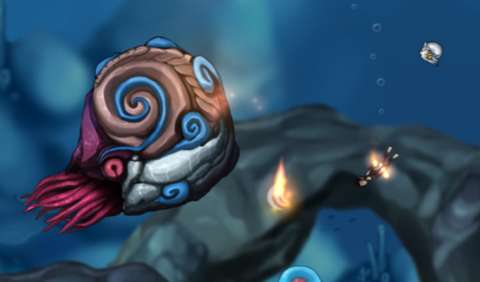
Optional boss fights are a bit more straightforward, because most of these bosses can be directly wounded by the Energy form’s attacks. However, the caveat is that they tend to be far more mobile than the mandatory bosses, so the player will need to move Naija about a lot. Incidentally, this also means that the Energy form is the only form that is practical against them. On the other hand, these boss fights are the best moments to use buff-granting food items such as the Spicy and Volcano Rolls.
Back in 2007, games with such boss designs would not have been pervasive in the indie scene, though games from the likes of Nintendo would have already treaded this ground. Nowadays, there are already plenty of indie games with memorable boss battles, such as the notable Titan Souls, so Aquaria’s boss battles would not have retained all of their impressiveness over the years. Still, they have aged well, unlike the fights against regular enemies.
ENVIRONMENTAL HAZARDS:
In addition to idiotic and troublesome wildlife which get in the way, there are also some hazards which are set into the environment. There does not seem to be any convincing in-universe narrative reason for these to be around. To elaborate, there are still-functioning mechanisms in the ruins of the civilizations which Naija would explore that either bar her way or act as traps, but which would have been quite counter-productive in making these places out to be places where people once lived.
Anyway, these traps appear to be in the game for the sake of having one aspect of platforming gameplay, which is the evasion or circumvention of traps or hazards. Some of these can be evaded by using Naija’s surging move, while others have to be circumvented by having Naija switch to forms that can pass through them. It is worth noting here that the Shield song is not effective against most of these.
A player who is already very familiar with such gameplay elements would not derive much fun from them. Fortunately, there are a few moments in the game where they are used in more meaningful ways, such as in boss fights.
Next, there are barriers, which discourage movement past them by inflicting damage on Naija if she encroaches on them. Steam vents are examples of these; usually, their presence would suggest that the use of the Spirit Form is needed.
Environmental hazards are particularly dense in the levels which lead up to the finale. These will test the player’s familiarity with the controls and Naija’s forms. For example, a clever player would learn that the Fish form’s small sprite and great speed make it the best form to swim through a series of hideous mouths which come out of the background wall.

LIVING TRANSPORTS:
There are two types of docile wildlife which provide means of transportation. One of them is a large seahorse which Naija can ride and steer using her singing, but it is probably safer to have Naija swim on her own so that the player can use her powers at any time. However, if the player can obtain a certain costume which Naija can wear, they become a lot faster and are able to ignore the effects of currents.
There is also a side activity involving seahorses. This is a race which the player can only win by making use of a specific form, and by using a seahorse to participate.
The other docile wildlife that acts as a mode of transportation are large ancient sea turtles. These effectively act as shortcut links between two regions of the underwater world. Using them can be a bit tedious though, because the player would be sent to another ancient turtle, specifically the next one in a rotation system which lists and cycles through the locales which the turtles are in.
HEALTH WORMS:
Certain secrets will only be revealed to ardent players who experiment a lot – or to a player who reads guides. One of these secrets concerns certain worm- or tadpole-like lifeforms, which are found in a rare few places.
If the player has Naija sing to these creatures with the correct tune, they will latch onto Naija, and somehow grant a semi-permanent health-regeneration buff which will last until she moves into another level. (Moving into another level removes buffs and de-buffs as well.)
HOME WATERS:
Home Waters is a level just outside of Naija’s home. It is easily the most serene region in the underwater world, and is generally safe. More importantly, this is the place where the player can restock on food supplies. After the player has unlocked a few Turtle-travel nodes, returning to the Home Waters to resupply becomes a bit easier.
The Home Waters has a lot of docile wildlife, which the player can either kill or interact with singing in order to obtain supplies from them. The former has been mentioned already. In the case of the latter, there is the example of the Eel. If Naija sings to it and attracts its attention, it will eventually yield some Eel Oil after having lingered about Naija for a while.
VERSE EGG:
After Naija has obtained her first power from external sources, the player would soon discover special artifacts known as “Verse Eggs”. These contain concentrations of what passes as the “life-force” in Naija’s world. She can break them open with her singing and proceed to absorb the life-force, thus increasing her reserves of health.
Verse Eggs are often located behind areas which can only be reached by making use of Naija’s powers. The later ones, in particular, may require a succession of use of powers. (At least one of them involves an optional boss fight too.)
PEARLS:
Throughout the game, the player would find massive pearls which are nestled about in a few places. These are facsimiles of door-knobs; they have to be brought with the Bind song over to the magical mechanisms which control certain gates. After the pearls have been inserted into these mechanisms, the pearls have to be powered with the Energy form’s charged attack in order to open the gates.

Rarely, the pearl mechanisms are used to activate other mechanisms instead. This tends to be part of puzzle solutions or as part of boss fights. There is perhaps a lost opportunity to diversify the role of these in the gameplay.
TREASURES:
The underwater world has some artifacts, relics, or simply peculiar lifeforms which Naija can discover and – somehow – transport back to her home. These are often found out of the way, in dead-ends, and often behind obstacles which the player has to remove by using Naija’s powers.
These treasures are mostly in the game for aesthetic purposes. For example, most large relics do little more than sit around in Naija’s home-cave.
Some others have more use, such as costumes that Naija can wear and obtain gameplay bonuses from. For example, there is the Crab Armor, which Naija can wear and gain reduction to damage. However, these only work when she is in her default form, and there are few reasons to remain in her default form, especially in the later parts of the playthrough when there is more danger.
PETS:
Some collectibles are in the form of friendly creatures, which, when found, are added to a list of creatures which Naija can summon into being at any time. There can be up to four of these, and they help in small, though sometimes inconsequential ways.
For example, one of the earliest pets which can be found is the nautilus hatchling. Like the nautilus hatchlings which the player will encounter as hostile creatures, they spin before they make a charging attack. However, it is not very good at anticipating the movement of opponents, making its contribution to a fight rather small.
Pets are not stopped by any obstacles; they can pass through any obstruction in Naija’s way. Therefore, they are effectively Naija’s defense satellite, to use a term from shoot-‘em-up titles.
RED CRYSTALS & GAME-SAVE SYSTEM:
By making use of the mysticism of the “Verse” in the fantastical world of Aquaria, the game designers have implemented a rudimentary but serviceable game-save system. Wherever the player can find solitary chunks of shimmering Red Crystals, regardless of their size, the player can save his/her progress and have Naija’s health completely replenished by having her interact with them.
If there is any problem with the game-saving system, it is there are only a few dozen slots for game-saves. Considering that the game is writing data onto the hard disk, there should have been no limit at all.
OUT-OF-WATER SEGMENTS:
About past the halfway point of a playthrough, Naija eventually reaches the surface of the underwater realm, poetically referred to in-game as the “Veil”.
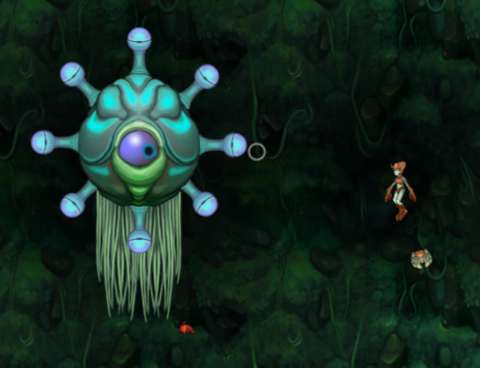
It is here where the player will learn about leaping out of water, something that Naija does with great gusto. There is even a backflip animation if the player can get the angle of the leap right.
However, the main draw of these segments is that the player might learn about a certain movement method that is only applicable when out of the water. The first step to learn about this movement method is to realize that out of the water, Naija cannot grip onto a rock wall against gravity for long. The second step is to learn that she must attempt to leap onto another surface in order to prevent her from simply falling.
If the player can keep these limitations in mind, he/she will also soon learn about the ‘secret’ areas of the Veil, namely places high above the water. Incidentally, some of the best food items and the ingredients to make them are found in these places.
The player will also learn about swimming up waterfalls, which is something that can be amusing to learn for the first time.
Ultimately though, the above-water segments are few when compared to the underwater ones. Their primary purpose is to show that the world of Aquaria is not completely underwater and the secondary one is to include some secret goodies there, but there will not be any substantial exploration of terrestrial regions, much less any encounter with the civilizations which live in these.
(The ‘secret’ ending for the game suggests that there would be a sequel which concerns this, but the main individuals behind Bit-Blot, namely Derek Yu and Alec Holowka, have since moved on to other projects.)
SUNKEN CITY SEGMENTS:
Most of the puzzles and obstacles in the game are easy to figure out, but the ones in the penultimate segment of the game, the Sunken City, might be a tad obscure. Some of them benefit from narration by Naija herself, but the others do not have enough hints.
For example, to make progress in the final part of the Sunken City, the player has to bring rocks of blue-grey material (supposedly clay) to a ghostly boy with the Bind Song. However, there is nothing to suggest that the boy wants clay, or anything to suggest that the City still has any clay remaining. The most which the player can do, without resorting to a guide, is to explore around and experiment.
VISUAL DESIGNS – IN GENERAL:
It should be apparent that Aquaria was designed with 2-D graphics in mind. There are two layers of visuals: the foreground and the background. The background is mainly there for aesthetics and is mostly static, though in the last level of the game, the player might want to keep an eye on things in the background.
The foreground is populated with animated sprites, while level boundaries are shown via crags of rock. Anything beyond the level boundaries, however, are displayed as utter blackness.
Most of the artwork consists of outlandish takes on real sea creatures and locales. It might irk some oceanic anthropology enthusiasts that there are inaccurate portrayals of creatures, such as spider crabs acting like spiders underwater, but then, Aquaria apparently takes place in a fantastical world.

All of the artwork is rendered in a mix of bold colours and muted shades, resulting in everything standing out when there is enough illumination to see them, and blending together if there is not.
There are some visual designs in Aquaria which are worth mentioning in detail, as will be done shortly.
VISUAL DESIGNS – MULTI-PORTION SPRITES:
Back in 2007, Aquaria is perhaps one of the earliest indie games to make use of the animation method of splitting a full-body sprite into limbs and torsos and linking them back together again so that they can be animated like digital facsimiles of puppets on strings. This animation method also allows the game’s designers to replace sprite portions with others, mainly for the purpose of displaying different costumes and clothes. (Incidentally, many fan-made mods for the game happen to take advantage of this.)
By the present day (2016 at this time of writing), Aquaria’s sprite animations would have seemed quite inferior and lazy when compared to the caliber of the same animation method which is used in the present day. This is because tertiary animations such as breathing are missing, thus making sprites like Naija’s look a bit stilted and puppet-like, despite the presence of secondary animations such as the bobbing that is to be expected of creatures which are floating in water.
VISUAL DESIGNS – IDLING ANIMATIONS:
If the player does not enter any control inputs, the player would eventually see some idling animations on the part of Naija, and later, Li as well. In the case of the latter, the couple embraces and a sort of dancing mini-game starts, using controls which are similar to that of riding sea-horses.
Some of the objects that Naija can interact with serve little to no gameplay purpose. In most of these cases, Naija would rest on them. These are likely there to give character to Naija and any other character or creature which may be involved. In the case of animations which appear to have Naija going to sleep, these restore her health, conveniently.
VISUAL DESIGNS – ILLUMINATION & DARKNESS:
There are many places in the game where the screen appears to dim, especially in places where the background gives the suggestion that Naija is swimming into an enclosed cave. (Not all enclosed caves are dark places though; there is no clear factor which decide which caves are dark and which are not.)
Darkness and light are not just a matter of aesthetics. In particularly dark areas, the mini-map also deactivates, and the player cannot bring up the map; this necessitates the use of the Sun form, which re-activates the map. Some hazardous creatures are also afraid of the Sun form’s light.
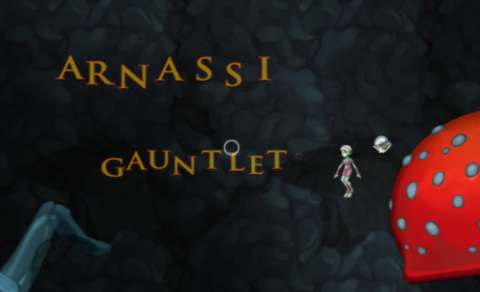
Secret areas are often bounded by deliberately darkened areas which cannot be illuminated in any way. This means that the player will need to resort to other means of spotting them, such as looking for any shadows which look out-of-place.
VISUAL DESIGNS – CYPHER:
A civilization would not be one if it does not have a writing system. It so happens that the fallen civilizations in the underwater world of Aquaria do have one common writing system (the reason for which is implied at the very end of the game).
Of course, veteran game consumers would suspect that this is just a replacement cypher for the alphabet (one made by a certain Jon Perry in this case), and they would not be wrong. The game designers have merely replaced letters in the alphabet with curvaceous glyphs. Still, the glyphs look convincingly carved into rocks and marble.
CAMERA ZOOM:
The player has little control over the zoom level of the camera. However, for most of the game, if not entirely, the automatic camera zoom is surprisingly effective at showing what the player needs to see. For example, in big, wide areas, the camera zooms far out, whereas for cutscenes, it zooms seamlessly in. (Zooming out may not be as smooth, however.)
An effective automatic camera zoom was a rarity in games during 2007, and perhaps still is even now.
SOUND DESIGNS – MUSIC:
The best sound designs in the game are its musical soundtracks, which are composed by Alec Holowka, who would later be involved in the musical composition for other indie games in the years after. Fittingly, they are the first aspect of the game’s audio which the player would hear upon starting the game.
Most of the tracks are electronic in nature. The main menu track is particularly notable for the hair-raising flourish that it starts with. The other tracks appear to have tunes which are subtly similar to those of this track, albeit with different tempo and empathic qualities. For example, the serene track “Light” is used for the very first scene in a playthrough, where Naija stares wistfully into the light shining into the largest chamber of the Verse Cave.
In the case of licenses of the game which have been bought on Steampowered or Humble Store (and by extent, Humble Bundle), they come with access to the standalone soundtracks of the game. (Incidentally, the licenses were made available on these digital stores years after 2007.)
Unfortunately, the original packaging of the game, as sold on Bit-Blot’s official website via the digital distributor Plimus (and which this review is based on), does not come with this bonus. This can irk customers who bought licenses for the game shortly after its debut in the indie game scene.
(Incidentally, Alec Holowka is purportedly one of the two lead designers of Aquaria as well. Why he would choose to focus on musical composition afterwards is not clear to this reviewer.)
This is not the only problem to be had with the licenses which are sold on the official website, as will be elaborated further later.
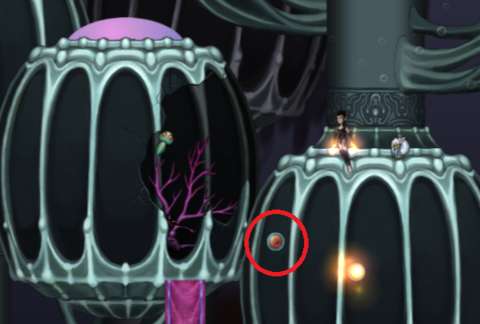
SOUND EFFECTS:
Real underwater noises would actually be quite difficult to listen to, mainly due to the dampening effect of water. However, this will not stop Alec Holowka, who is the overall sound designer for the game as well as its music composer, from including some artificially fantastical noises in the game. For example, defeated enemies emit a low rumble as their sprites disappear amidst pretty particle effects.
Nevertheless, they mostly serve their function well, which is to indicate via audio cues that something is happening. For example, a harsh whoosh can be heard whenever a charged attack has been prepared.
GLITCHES:
There are a few overlooked but minor glitches in the game. Chief amongst these is how items which are yielded by defeated enemies would shoot out of them when they are slain – sometimes through and past level boundaries (thus making them irretrievable).
BIT-BLOT NOT RESPONDING TO OFFICIAL WEBSITE EMAIL CONTACT:
This reviewer’s experience with the game has been mostly great, especially in-game. Outside and away from the game, however, it has been rather sour.
Firstly, it should be said here that obtaining a license for the game from the official website entails the reception of a temporarily open URL for the download of a DRM-free copy of the game; this is the modus operandi of Plimus, one of Bit-Blot’s distribution partners. However, if the license owner would lose the copy – and in the case of this reviewer, through an unexpected hard disk failure – the license owner is to liaise with the game-maker first, namely Bit-Blot.
Unfortunately, no one was maintaining Bit-Blot’s official email correspondence during 2010, when this reviewer attempted to contact Bit-Blot through official channels. Six attempts were made over the course of several months, without any response. (This happened before Aquaria became available on Steam, the iOS store and the Humble Store in the years after.)
This reviewer only managed to obtain redress after contacting Plimus, which apparently still holds partial distribution rights to the game, at least through Bit-Blot’s official site. Only after explaining Bit-Blot’s failure to reply to this reviewer’s attempts at correspondence, this reviewer was provided another temporary URL to download another copy.
SUMMARY:
Aquaria has presentation which would captivate anyone who has a sense of appreciation for the beautiful and artistic. There is also noticeably significant diversity in its gameplay mechanisms to whet the appetite of game consumers who prioritize complexity of gameplay over aesthetics. However, the experience of combat can seem to be uneven, considering the contrast between the more interesting boss fights and the bland encounters with regular enemies.
Yet, despite the game’s generally great designs, its customer service is not exactly as comparable. There has to be a warning here about purchasing a license from the game’s official website, because Bit-Blot’s official email correspondence, as mentioned on the site, is not exactly reliable.
